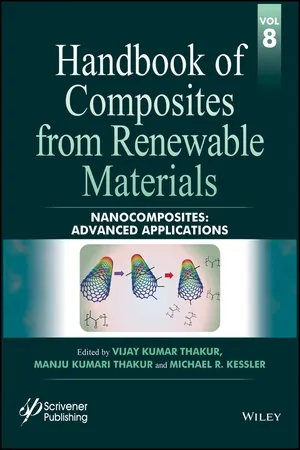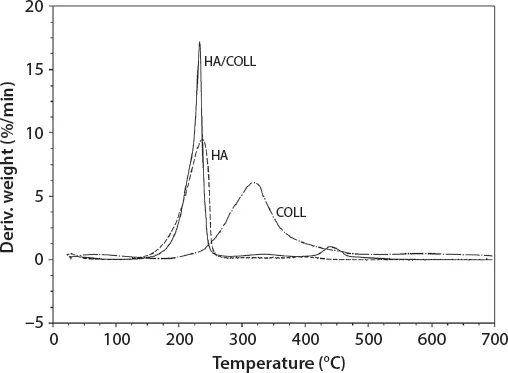
Handbook of Composites from Renewable Materials, Nanocomposites
Advanced Applications
- English
- ePUB (mobile friendly)
- Available on iOS & Android
Handbook of Composites from Renewable Materials, Nanocomposites
Advanced Applications
About this book
This unique multidisciplinary 8-volume set focuses on the emerging issues concerning synthesis, characterization, design, manufacturing and various other aspects of composite materials from renewable materials and provides a shared platform for both researcher and industry.
The Handbook of Composites from Renewable Materials comprises a set of 8 individual volumes that brings an interdisciplinary perspective to accomplish a more detailed understanding of the interplay between the synthesis, structure, characterization, processing, applications and performance of these advanced materials. The Handbook comprises 169 chapters from world renowned experts covering a multitude of natural polymers/ reinforcement/ fillers and biodegradable materials.
Volume 8 is solely focused on the Nanocomposites: Advanced Applications. Some of the important topics include but not limited to: Virgin and recycled polymers applied to advanced nanocomposites; biodegradable polymer–carbon nanotube composites for water and wastewater treatment; eco-friendly nanocomposites of chitosan with natural extracts, antimicrobial agents, and nanometals; controllable generation of renewable nanofibrils from green materials and their application in nanocomposites; nanocellulose and nanocellulose composites; poly(lactic acid) biopolymer composites and nanocomposites for biomedical and biopackaging applications; impact of nanotechnology in water treatment: carbon nanotube and graphene; nanomaterials in energy generation; sustainable green nanocomposites from bacterial bioplastics for food-packaging applications; PLA nanocomposites: a promising material for future from renewable resources; biocomposites from renewable resources: preparation and applications of chitosan–clay nanocomposites; nanomaterials: an advanced and versatile nanoadditive for kraft and paper industries; composites and nanocomposites based on polylactic acid obtaining; cellulose-containing scaffolds fabricated by electrospinning: applications in tissue engineering and drug delivery; biopolymer-based nanocomposites for environmental applications; calcium phosphate nanocomposites for biomedical and dental applications: recent developments; chitosan–metal nanocomposites: synthesis, characterization, and applications; multi-carboxyl functionalized nanocellulose/nanobentonite composite for the effective removal and recovery of metal ions; biomimetic gelatin nanocomposite as a scaffold for bone tissue repair; natural starches-blended ionotropically gelled microparticles/beads for sustained drug release and ferrogels: smart materials for biomedical and remediation applications.
Frequently asked questions
- Essential is ideal for learners and professionals who enjoy exploring a wide range of subjects. Access the Essential Library with 800,000+ trusted titles and best-sellers across business, personal growth, and the humanities. Includes unlimited reading time and Standard Read Aloud voice.
- Complete: Perfect for advanced learners and researchers needing full, unrestricted access. Unlock 1.4M+ books across hundreds of subjects, including academic and specialized titles. The Complete Plan also includes advanced features like Premium Read Aloud and Research Assistant.
Please note we cannot support devices running on iOS 13 and Android 7 or earlier. Learn more about using the app.
Information
Chapter 1
Virgin and Recycled Polymers Applied to Advanced Nanocomposites
Abstract
1.1 Introduction


Table of contents
- Cover
- Title page
- Copyright page
- Dedication
- Preface
- Chapter 1: Virgin and Recycled Polymers Applied to Advanced Nanocomposites
- Chapter 2: Biodegradable Polymer–Carbon Nanotube Composites for Water and Wastewater Treatments
- Chapter 3: Eco-Friendly Nanocomposites of Chitosan with Natural Extracts, Antimicrobial Agents, and Nanometals
- Chapter 4: Controllable Generation of Renewable Nanofibrils from Green Materials and Their Application in Nanocomposites
- Chapter 5: Nanocellulose and Nanocellulose Composites: Synthesis, Characterization, and Potential Applications
- Chapter 6: Poly(Lactic Acid) Biopolymer Composites and Nanocomposites for Biomedicals and Biopackaging Applications
- Chapter 7: Impact of Nanotechnology on Water Treatment: Carbon Nanotube and Graphene
- Chapter 8: Nanomaterials in Energy Generation
- Chapter 9: Sustainable Green Nanocomposites from Bacterial Bioplastics for Food-Packaging Applications
- Chapter 10: PLA Nanocomposites: A Promising Material for Future from Renewable Resources
- Chapter 11: Biocomposites from Renewable Resources: Preparation and Applications of Chitosan–Clay Nanocomposites
- Chapter 12: Nanomaterials: An Advanced and Versatile Nanoadditive for Kraft and Paper Industries
- Chapter 13: Composites and Nanocomposites Based on Polylactic Acid
- Chapter 14: Cellulose-Containing Scaffolds Fabricated by Electrospinning: Applications in Tissue Engineering and Drug Delivery
- Chapter 15: Biopolymer-Based Nanocomposites for Environmental Applications
- Chapter 16: Calcium Phosphate Nanocomposites for Biomedical and Dental Applications: Recent Developments
- Chapter 17: Chitosan–Metal Nanocomposites: Synthesis, Characterization, and Applications
- Chapter 18: Multicarboxyl-Functionalized Nanocellulose/Nanobentonite Composite for the Effective Removal and Recovery of Uranium (VI), Thorium (IV), and Cobalt (II) from Nuclear Industry Effluents and Sea Water
- Chapter 19: Biomimetic Gelatin Nanocomposite as a Scaffold for Bone Tissue Repair
- Chapter 20: Natural Starches-Blended Ionotropically Gelled Microparticles/Beads for Sustained Drug Release
- Chapter 21: Ferrogels: Smart Materials for Biomedical and Remediation Applications
- Index
- End User License Agreement